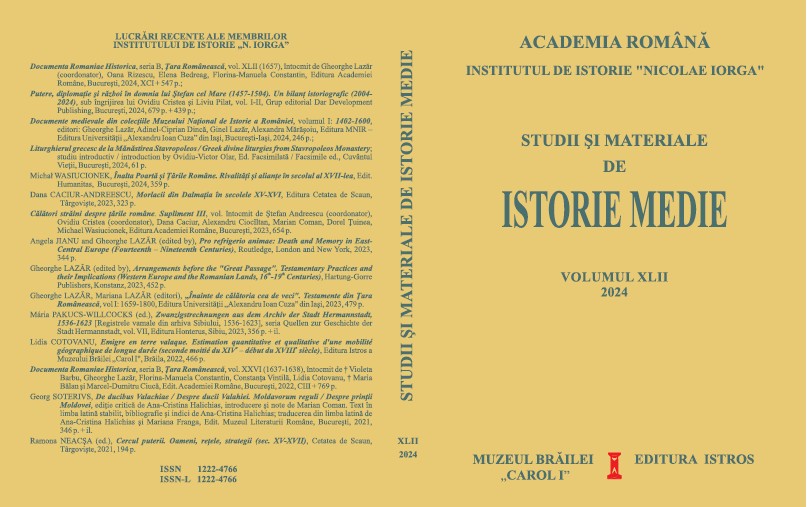Constituirea statului medieval al Moldovei
The State-Making of the Medieval Moldavia
Author(s): Victor SpineiSubject(s): History, Diplomatic history, Military history, Middle Ages
Published by: Institutul de Istorie Nicolae Iorga
Keywords: medieval state of Moldavia; Transylvania; Wallachia; Dragoș; Bogdan; Hungarian Kingdom; Golden Horde; Poland; Halych-Volhynia; Lithuania; Mongols;
Summary/Abstract: The origins of most medieval states in Europe are shrouded in a dense fog of uncertainty, due to the scarcity and ambiguity of the documentary evidence. Moreover, the few facts that can be established with some modicum of certainty have received an aura of myth that makes the task of the historian difficult. Much like elsewhere, the rise of the medieval states in the Romanian lands has generated a considerable body of literature, even though a comprehensive volume is still lacking. In what follows, I will rely not only on the few written sources available for he lands between the Carpathian Mountains and the Dniester River, but also on those pertaining to the neighboring regions, as well as the results of archaeological and numismatic research. A good number of historians conflate the achievement of independence from the Hungarian Kingdom with the foundation of the Romanian state east of the Carpathian Mountains. However, the process of state formation ends only with the configuration of the administrative structure, when the territorial nucleus built by groups of rebels from Hungary included not only the valley of the Moldova River, but also the lands farther to the east, up to the Dniester River. The rise of the medieval state of Moldavia, a process that lasted some 25 years, is unlike other such processes in Europe. Although essentially of local production, the rise of Moldavia was consistently supported by groups of immigrants from Maramureș, where political instability, due primarily to the implementation of the royal administration interfered with political aspirations at the local level. Both Romanian territories were confronted with the hegemonic tendencies of the Golden Horde and the Hungarian Kingdom. The involvement of Romanians from Maramureș in the state formation is primarily a political act and can only be categorized as a demographic phenomenon to a limited extent, since in the 14th century the population of Maramureș was numerically small and without the ability to sustain a consistent migration flow across the mountains. Although they had different strategic objectives, the Hungarian kings had a significant role in shaping the demographic, economic and political environment in the Carpathian-Dniester region. At least initially, the main goal of the royal policy was to secure the defense of the eastern borders of the kingdom against the attacks of the Tatars. Later, the goal changed and Hungarian kings aimed at estabilishing their authority over the Romanian lands outside the Carpathian Mountains, in order to use them as launchpad for expeditions against the Tatars, Ruthenians and Lithuanians. Meanwhile, with the constant support of the Holy See, they also became interested in Catholic proselytism. To reach those new goals, the Hungarian king used Romanians from Maramureș as proxies, no doubt counting on their familiarity, at least in terms of language, with conditions in Moldavia. The idea backfired, because Romanians in Maramureș and Moldavia had other plans, and their alliance was sufficiently strong to push aside the party of Dragoș and his descendants, thus effectively removing the Hungarian suzerainty from Moldavia and preventing its annexation to the Angevin monarchy. Even though Bogdan may be seen as having specifically Romanian aspirations, and Dragoș as serving the interests of the Hungarian king, local legends, such as found especially in Bukovina, glorified the latter as the founder of the state, to the total neglect of Bogdan. Bogdan and his men most likely ruled over a third of the Carpathian-Dniester territory, since the regions east of the middle and lower reaches of the Siret were part of the Golden Horde at that time, albeit directly administered not by the khans in Sarai, but by their subordinates. The interruption of the circulation of Horde coins in southeastern Moldavia suggests that the Tatar authorities and the Islamized Turkic groups that had been settled in this region were forced to move to the left bank of the Dniester in the years 1369-1370, under circumstances that are still unclear. It is known when the Romanian rulers in northwestern Moldavia extended their authority over the vast area abandoned by the Tatars. The process of state formation concluded with the incorporation of the lands between the Middle and Lower Dniester, on one hand, and Black Sea shore, on the other hand. It must have been an arduous process, requiring labor, determination, and perseverance. Achieving statehood was an essential step in the history of Romanian communities in the lands to the east from the Carpathian Mountains. In many ways, it provided the necessary protection for their survival. At the same time, the medieval state created the demographic, economic, institutional, religious, and cultural conditions for forging a new identity, the understanding of which is fundamental for what constitutes Romanian-ness today.
Journal: Studii şi Materiale de Istorie Medie (SMIM)
- Issue Year: XLII/2024
- Issue No: XLII
- Page Range: 11-118
- Page Count: 108
- Language: Romanian
- Content File-PDF

